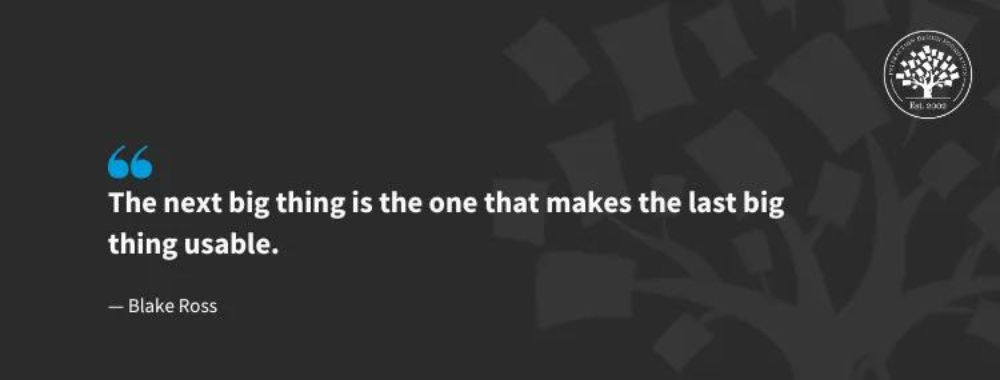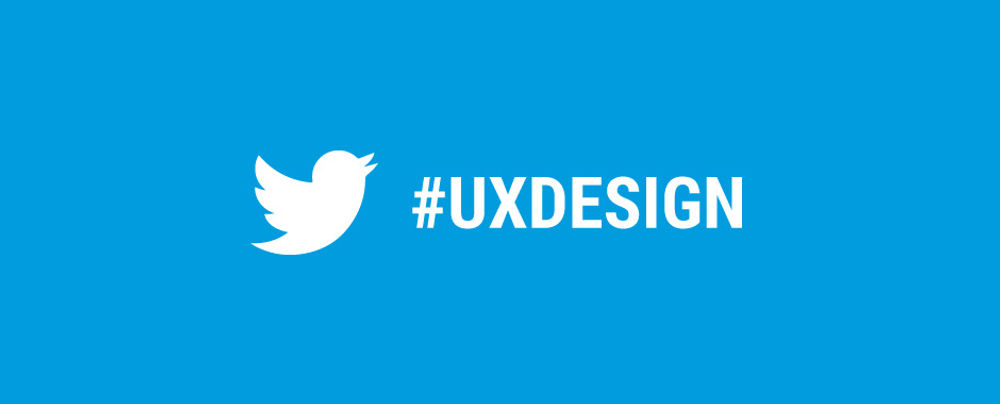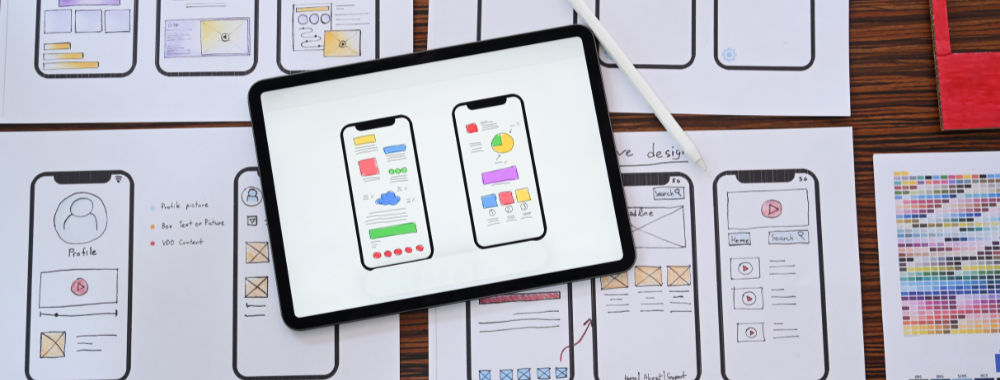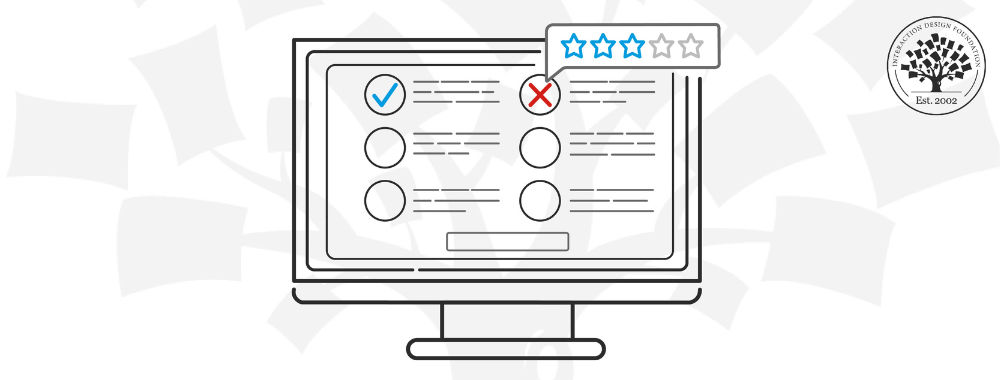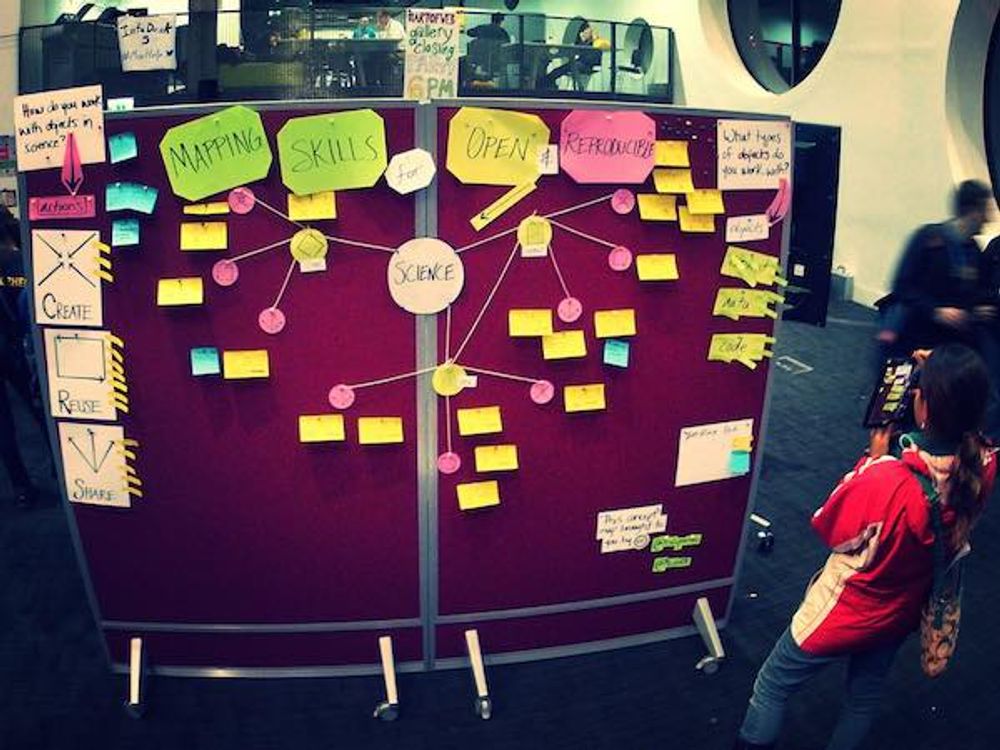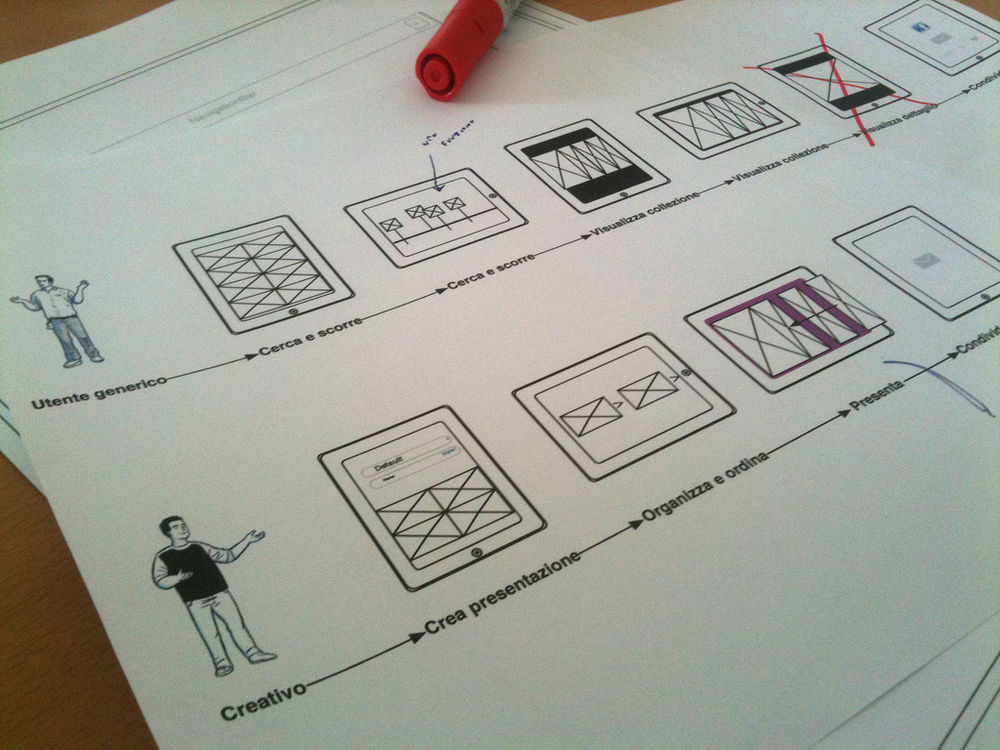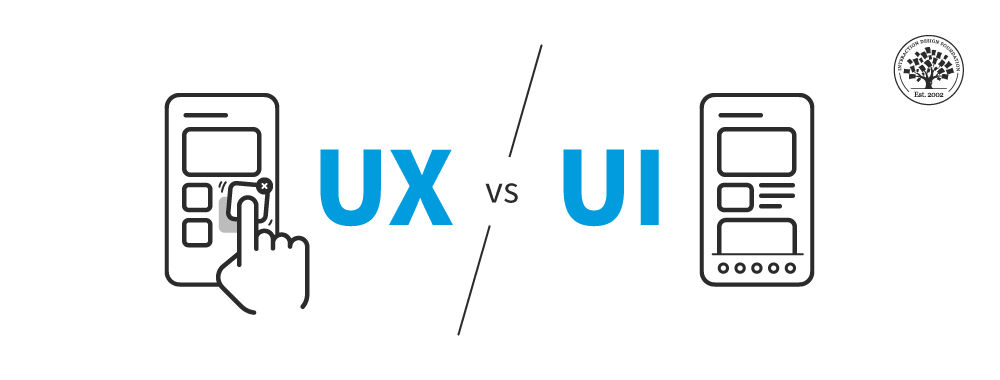In design—and anywhere else that innovation is involved—words can often paint a picture far more vividly than strokes on a canvas ever could, and that’s true in UX design (user experience design), where inspiration often comes from straightforward phrases. These brief quotes are way more than just words—they’re gems of knowledge that showcase the core of UX, packeted into a line or two so they can stick in the mind and inspire us—designers, designers-to-be, and even the hitherto-casually interested—to think more, design better, and innovate stronger. But there’s even more than that—to be sure—as these quotes question our viewpoints, and can help us shake ourselves out of a rut (sometimes a creative block, sometimes because of déformation professionelle) or spark our creativity and add the vitality our work needs to make escape velocity and soar high into the marketplace.
As the Interaction Design Foundation (IxDF), we stand at the forefront of the UX design industry, and our passion and commitment to the industry is something we’re proud to mirror in our vast repository of educational resources, community engagement, and collaborations with industry leaders.
What is The Power of UX Quotes to Help Designers?
UX quotes pack a powerful punch—and even if we also love good literary quotes that reflect golden nuggets of truth about the human condition, too, the UX ones are what inspire, guide, and serve as a compass, pointing toward the heart of user-centered design. But it’s also important to define several points as to why these quotes are so impactful, as in, to the point that they play such a crucial role and pack the clout to shape the very field of UX design—and not just the private, individualized needs of the designers who hold them in such high esteem in their various idiosyncratic ways.
1. Inspire Creativity
User experience quotes do a great deal more than give food for thought—they trigger creative juices and encourage designers to think in ways where they explore beyond the boundaries of their current ways of design thinking. And, to be sure sure, quotes from UX stalwarts often convey unorthodox approaches and innovative mindsets that can put something pretty important in the mind.
It’s easy when you’re pondering design challenges—or even agonizing over ways to access the best parts of the solution space—to forget that true creativity is available to you and that you’re not deficient in your thinking (i.e. that you’re missing a point about the “right” way to do something). When you get this buzz of inspiration, it might not just be a source of relief with the realization that you’re thinking like a designer but the fuel to propel your creative process to new heights.
2. Foster Empathy
At the very heart of UX design lies empathy—and empathy is an often-misunderstood word, but it’s the ability to understand and share the feelings of others. And since they’re steeped in real-life experiences and insights, UX quotes remind designers of just how vital empathy is in their work—that it’s got to be about the people who’ll use the digital solution, service, or what have you. From that, a mindful designer can use empathic insights as a kind of fulcrum to lever an empathetic approach to design, prioritizing users’ needs, emotions, and experiences so what comes about is all about the users.
Watch how to empathize with users to collect insights and fuel your design process.
Show
Hide
video transcript
- Transcript loading…
3. Drive User-Centered Design
In a similar vein (no pun intended while we’re talking about hearts above!) the essence of UX design is to create a product that’s got to tick a few boxes. To be sure, it has to meet users’ needs, but it’s got to provide an engaging and enjoyable experience, too—or, depending on the nature of the product (think of something like a product for help doing taxes), at least de-stress them and keep them calm and on board. In any case, UX quotes often emphasize this user-centered design philosophy, and serve up a reminder for designers to focus on end-users and their experiences.
It doesn’t end there, though: designers who incorporate UX quotes into the interaction design process can notice they’ll have a transformative impact, too. For one thing, they encourage a culture of continuous learning and inspiration, and you’ll find that if you share and discuss UX quotes within your team, it’s something that can keep everyone motivated and creatively stimulated.
There’s still more—they can guide brainstorming sessions and steer them toward user-centric ideas and solutions, the words themselves serving as a kind of compass to keep thinking on point and morale held high, all the while serving as touchstones during the design process to make sure that the team stays on point and in line with the fundamental principles of UX design.
4. Guide Design Thinking
UX quotes can serve as mini-guides—a magnificent achievement for what are often just a few strings of words, but in spite of their size they can steer design thinking towards human-centered design. Almost anthemic in their power, they reflect industry veterans’ wisdom, lessons learned, and successful strategies, and they’re quotes that can offer valuable guidance for problem-solving and decision-making in design—while assuring those who hear and read them that they’re not alone in what they must do.
Watch why a human-centered design approach is essential for design thinking.
Show
Hide
video transcript
- Transcript loading…
What’s This Curated Collection of Impactful UX Quotes?
Let’s start with our curated collection of the best user experience quotes from business leaders, design experts, visual designers, and people at the top of their industries.
After all the powers we’ve attributed to them, we can add that—as you might suspect by now—these impactful UX design quotes are ones we’ve selected with care from the insights of industry experts and thought leaders. Each quote sheds light on different aspects of UX design and encapsulates a specific theme or philosophy, and—for every one of them—we’ve put in a detailed explanation and analysis to highlight why it’s relevant and what its practical application is in design, so you’ve got a convenient frame of reference right there.
1. Theme: Clarity in User Experience
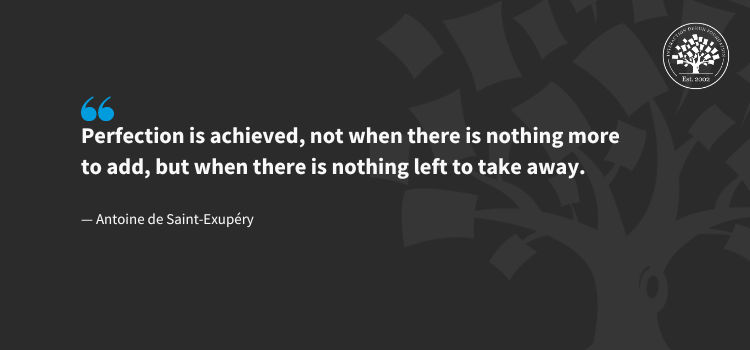
© Interaction Design Foundation, CC BY-SA 4.0
"Perfection is achieved, not when there is nothing more to add, but when there is nothing left to take away."
— Antoine de Saint-Exupéry
Antoine de Saint-Exupéry was a celebrated French writer and pioneering aviator, and while he may not have been a UX designer by profession, since he lived before the term came into being, anyway, his words do ring true in the design world of the 21st century—and promise to be relevant for all time. His quote emphasizes how important simplicity and clarity are in design—something that makes perfect sense when you factor in the point that for aviators in the early decades of the 20th century who were pioneering the best designs to fly with (and on!), the design of the machine carrying them could be a life-or-death proposition.
For sure, de Saint-Exupéry’s words hold true in the digital age—and they’re a great encouragement for designers to eliminate unnecessary elements until the design does get to be perfect through its simplicity, more or less like an anthem for designers to practice minimalist design principles, focus on core functionalities, and not over-complicate anything that might spoil the user experiences and risk that all-vital “magic” of—you guessed it—a seamless experience.
2. Theme: User-Centered Design
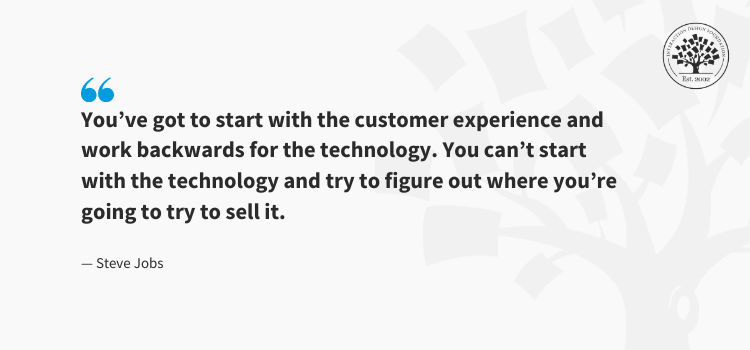
© Interaction Design Foundation, CC BY-SA 4.0
"You’ve got to start with the customer experience and work backwards for the technology. You can’t start with the technology and try to figure out where you’re going to try to sell it."
— Steve Jobs
Steve Jobs—co-founder of Apple—underscores the importance of user-centered design with this quote, and he emphasizes in it that technology should serve the user experience, not dictate it. As in, you don’t invent something and then try to see where you can plug it in—hence the old saying, to put the cart before the horse—but instead you craft something that serves what people need.
We can see this in our mind’s eye if we bring in an analogy; imagine if designers long ago had come up with the aqualung (as in, long before it actually did emerge—no pun intended), but they were innovating in the middle of a desert with no bodies of water within many hundreds of kilometers. Imagine the difficulties they’d face trying to “sell” the idea to “users” who would have no use for it (and it’s not a good idea to try “swimming” through sand dunes).
So, dear designer, that’s why you’ve got to focus on the desired user experience and then work backwards until you find the technology that best facilitates this experience—and so prioritize users and their experiences over the “glitz” and “glam” and outright allure of cutting-edge technology, however cool it may seem to be.
3. Theme: The Role of Options in Design
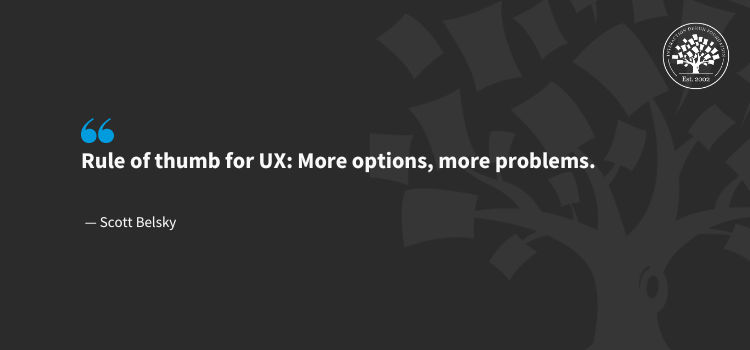
© Interaction Design Foundation, CC BY-SA 4.0
"Rule of thumb for UX: More options, more problems."
— Scott Belsky
In this one, Scott Belsky—Adobe’s Chief Product Officer—has got a tidy quote here that serves as a critical reminder, potential warning, and (therefore) strong guardrail for UX designers who might otherwise stumble and “spoil” their products’ users by giving them too many options and make them freeze up, overwhelmed with the offerings (no matter how well-intentioned you may have meant these “extras” and “nice to haves” to be!). Indecision is nobody's friend in design (and many other places!), and, in fact, it’ll be the reverse of doing them a favor, because rather than being grateful for the designer’s generosity, they’ll tend to veer into the dreaded zones of user frustration and negative experiences.
Belsky’s statement underlines why the need is so real—and great—for a thoughtful, streamlined design that prioritizes key features and functions to come out of a designer’s and design team’s efforts. While it’s easy—especially in such a competitive industry as tech—to seek to outdo rival products with neat feature after neat feature after neat feature, for example—the best option is, instead, to reduce complexity and focus on simplicity, and so create a smooth and effective user journey.
4. Theme: Design Philosophy
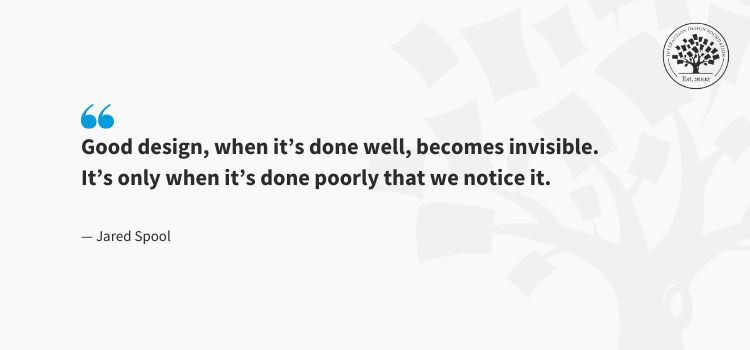
© Interaction Design Foundation, CC BY-SA 4.0
"Good design, when it’s done well, becomes invisible. It’s only when it’s done poorly that we notice it."
— Jared Spool
Jared Spool—a renowned writer, researcher, speaker, educator, and expert on usability, software, design, and research—gives us a quote that on the surface might seem counterintuitve to some at first glance. But it’s an accurate picture of what happens, and this quote emphasizes how successful designs go unnoticed while they serve users’ needs without effort. It’s not that users are ungrateful for designs that are done well—no, it’s just that good design becomes kind of “invisible,” part of the user’s subconscious experience and enables intuitive interaction without drawing any attention to itself. However, when a design is flawed—and when it’s not doing its “job” right—it becomes obvious, sticking out like a proverbial sore thumb, and a bad design interrupts the user’s flow and draws focus away from the task.
This kind of mirrors human nature in the sense that feedback was once maybe more synonymous with a “complaints department” than a “department of praise” (in other words, you’d seldom hear good things if customers had things to say). In any case, for UX and UI designers, interruption and the breaking of flow are the arch-enemies of a seamless experience; users shouldn’t have to think or—worse—hesitate to have to think about the digital design they’ve got in front of them, for example.
5. Theme: Testing and Iteration
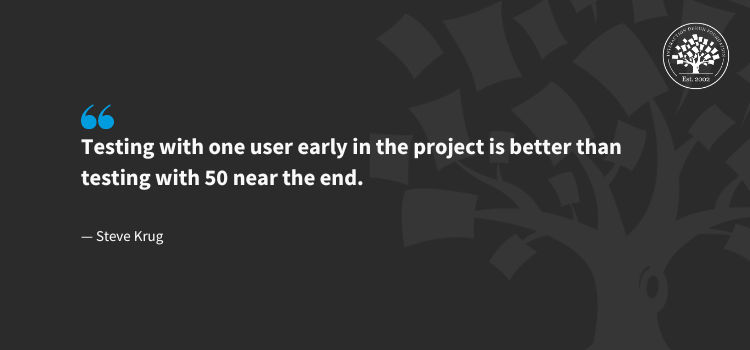
© Interaction Design Foundation, CC BY-SA 4.0
"Testing with one user early in the project is better than testing with 50 near the end."
— Steve Krug
In this quote, Steve Krug, a prominent user experience (UX) professional and author, puts it why early and frequent testing is a vital thing to do—and to get in the habit of doing—and it’s hard to overstate just how important it is to start good and early with getting that feedback in to guide things!
Many think testing is a huge task—almost fearing it as something to procrastinate over and just hope for the best later on, once a lot of work’s been done (because some stakeholders or even designers might make the mistake of just thinking they know what the users want). But there’s a real risk that you won’t do it soon or often enough if it seems big—hence why an early, simple test can be more helpful than a complex one later. It’s best to test early when you can still use what you learn from it—and course-correct just a little “distance” from the start, before you might go way off if you find out things are “off course” later on. So, user testing should never be an afterthought; plug it in early and keep it going for those “little steps” too, so the bigger steps go in the right direction.
Watch as UX Strategist and Consultant, William Hudson explains important points about usability testing:
Show
Hide
video transcript
- Transcript loading…
6. Theme: The Cost of Bad Design
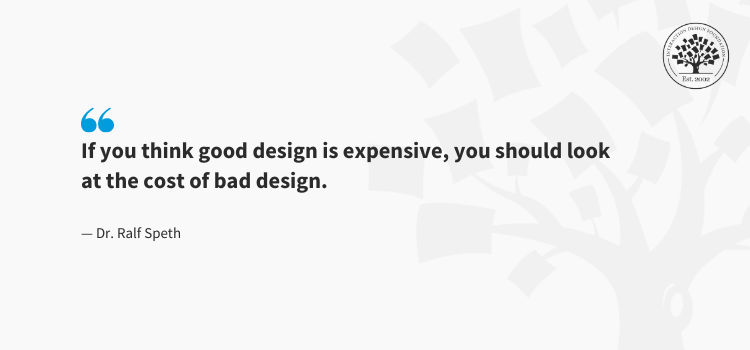
© Interaction Design Foundation, CC BY-SA 4.0
“If you think good design is expensive, you should look at the cost of bad design."
— Dr. Ralf Speth
This quote by Dr. Ralf Speth, former CEO of Jaguar Land Rover, can pretty much serve as a fair warning that underscores just how vital it is to invest in good design. In fact, for brands that might grumble and bellyache that parts of a design—and they’re parts that time will tell to be necessary ones—cost too much, this is something a designer should be ready to put to them, as a kind of clarion call before mistakes get made and the costs of missing the mark soar petty high and rack up massive headaches for brands.
The essence of the quote lies in the fact that the cost of creating a good design might seem high upfront, but—echoing the wisdom of the previous quote too—the repercussions of a poor design getting released can be far, far more costly if something that’s not-so-good makes it onto the market. Nasty surprises can happen for the brand when the ultimate tests indicate a flop, to be sure, and they’re repercussions that can range from user dissatisfaction and loss of customers to the need for substantial redesign efforts and reputation damage.
The “take away” is nice and straightforward: to keep things on point (and avoid rude awakenings later!) invest in a well-thought-out, user-centric design from the beginning—the brand will be much happier, and healthier, for it in the long run.
7. Theme: Simplicity and User-Friendliness
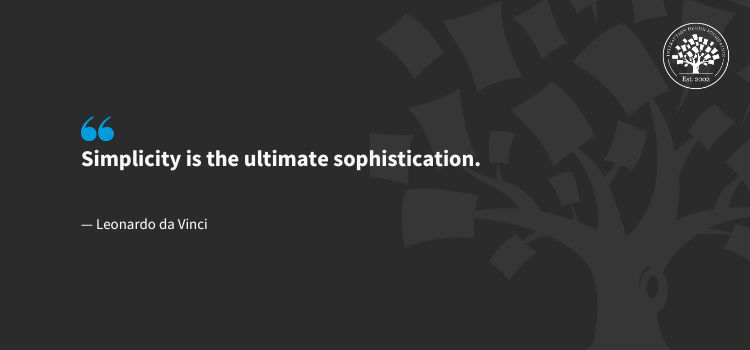
© Interaction Design Foundation, CC BY-SA 4.0
"Simplicity is the ultimate sophistication."
— Leonardo da Vinci
Although Leonardo da Vinci predated UX design by almost 500 years, that shouldn’t have to matter at all, not least because the nugget of wisdom from the Renaissance-era polymath is spot-on about a core principle in product design—and that principle is, quite simply, simplicity itself. You can take da Vinci’s five-word gem deeper than the “face value” of what some might call even a near oxymoron (“But isn’t sophistication about not being basic or crude?” they think, while missing the point of pure simplicity!). And when you realize that simplicity isn’t just about minimalism but about removing complexity until only the essential remains there, you’ll be on to something powerful with your design work.
Keep that as a credo or mantra, and you might find it’ll help lead you to designs that are practical, user-friendly, and elegant, and the more straightforward a design is, the easier it becomes for users to not just understand but interact with it as well. Not for nothing, then, did this inventor and proto-UX-designer (as well as artist, sculptor, and more!) get to grips with designing machines for flying and going beneath the waves—he knew full well the need to have zero confusion on board such endeavors!
For UX and UI (user interface) designers, such life-or-death matters may be off the cards, but there’s a different kind of “mission critical” status to watch for—keep your users unconfused! To be sure, simplicity is still vital to have on digital screens, for example, and achieving simplicity calls for a deep understanding of the users’ needs and—from that—selecting design elements with care, a sophisticated process that aims to deliver a seamless, effortless user experience every time.
8. Theme: Paying Attention to Users
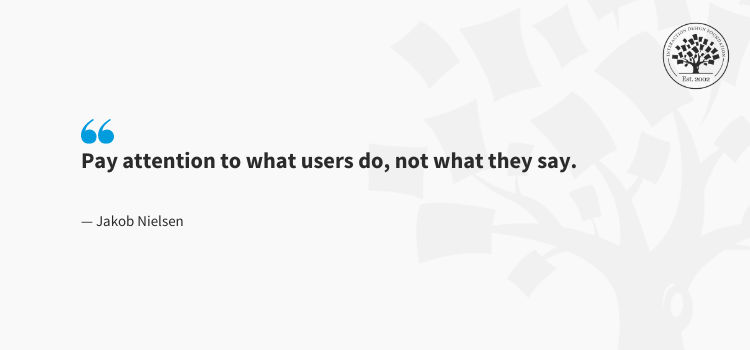
© Interaction Design Foundation, CC BY-SA 4.0
"Pay attention to what users do, not what they say."
— Jakob Nielsen
Renowned usability consultant Jakob Nielsen emphasizes what the importance of observing user behavior over merely relying on their words is in this potential “wake-up call” for user researchers who would take their users’ declarations of what their user behavior is like at face value over the actual users’ behaviors, themselves.
While feedback provides valuable insight, to be sure, it can sometimes be influenced by what users think they want—or should do—rather than reflect their true behavior. This isn’t to say that many users are liars who spout arrant nonsense to throw off unsuspecting designers from meeting their true design goals. It means, instead, that designers who observe how users interact with a product can spot genuine struggles and needs that come up.
For instance, think of a usability test situation where some users might play down or mute any doubts or problems they had with a digital product, which could be because they want to put politeness ahead of honesty (and not “hurt the feelings” of the designer), or because they think they might look “stupid” if they come out and say they ran into trouble with aspects of the digital solution, or because they think they need something they really don’t and their actions prove that, anyway.
What the idea with this quote is is for designers to prioritize user behavior observations over their preferences—and it’ll help light the way to designs that better accommodate real-world use and enhance the user experience.
Watch as UX Designer and Author, Laura Klein explains important points about how to think in terms of good enough and create better features for the users.
Show
Hide
video transcript
- Transcript loading…
9. Theme: Innovation and Usability
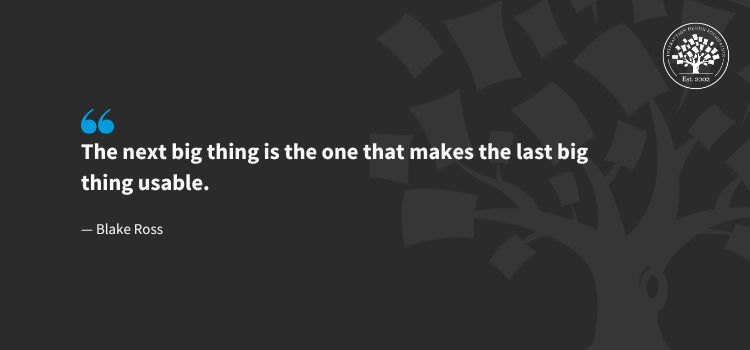
© Interaction Design Foundation, CC BY-SA 4.0
"The next big thing is the one that makes the last big thing usable."
— Blake Ross
Blake Ross—one of Mozilla Firefox's co-creators—presents an insightful perspective on innovation and puts a nifty emphasis on the point that true innovation doesn’t just involve creating new technologies—it’s about making the technologies accessible, user-friendly, and beneficial for the masses (i.e. of people who should be able to access, use, and enjoy it).
To get why this is so vital a thing to have, it might be a good idea here to imagine a dystopian society in a parallel universe—so, go on and picture a society if you will where super-techie types and hardcore programmers are the only ones who can use the internet, as in even get on there in the first place and then make the most of online delights galore. If the split between those who can write code in their sleep and the rest of humanity were to mean that only the ultra-computer literate could get online, wouldn’t it be a pretty depressing, scary, and polarized world—for both the majority of people, who couldn’t access the internet, and the technocrats they would come to envy and resent?
So, the “next big thing” isn’t just about novelty but about enhancing the usability of existing technologies, too—and it’s a pretty noble philosophy when you consider it; about crafting a user experience that makes the technology seamlessly integrate into users’ lives, so amplifying its value and impact and improving the lives of everyone who can use it (and, when it’s nice and accessible, they can!).
10. Theme: Problem-Solving in Design
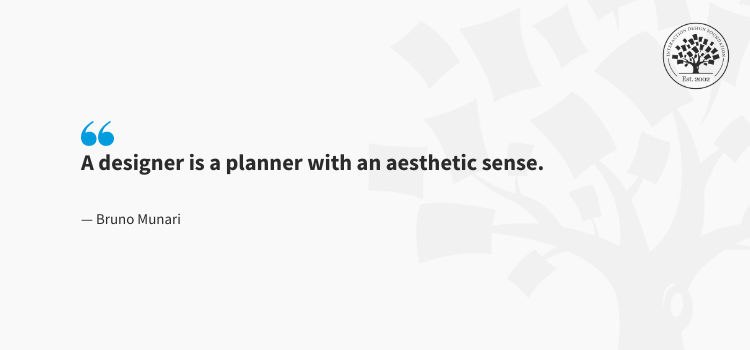
© Interaction Design Foundation, CC BY-SA 4.0
"A designer is a planner with an aesthetic sense."
— Bruno Munari
Look into the quote by Bruno Munari—a multifaceted Italian artist, designer, and inventor—and you’ll see how design isn’t just about creating aesthetically pleasing objects or interfaces; no, it’s about strategic planning and problem-solving, too.
It’s easy to see how apt this quote is if you look at the distinction between art and design, and how there’s a division where artists can more or less pretty much just “let rip” and see what strikes a chord with the (art-buying) public. Designers—unless they’re designing way-out-there fashion creations that take them far (and make them rich)—don’t have it so “easy,” but therein lies the beauty of what designers do, since they aren’t just creators of beautiful things; they’re planners—rational thinkers who analyze problems, devise strategies, and create visually pleasing, functional, and efficient solutions.
Munari’s quote emphasizes the depth and breadth of a designer’s role, and it’s a fitting reminder that good design is as practical as it is beautiful—that what turns up for the users who encounter a good design has got to pull its weight and do the job to take them where they want to “go” and get their problems solved and their wants or needs met to the point that they’re delighted.
Yes, dear designer, each design element that goes into—or onto—a design has got to serve a purpose and fit into a larger plan that considers user needs and business goals, and that’s where efforts early on like research and user testing will come to be of incalculable value if a design solution like an app or brand website (or what have you) hits it big in the marketplace.
11. Theme: User Engagement
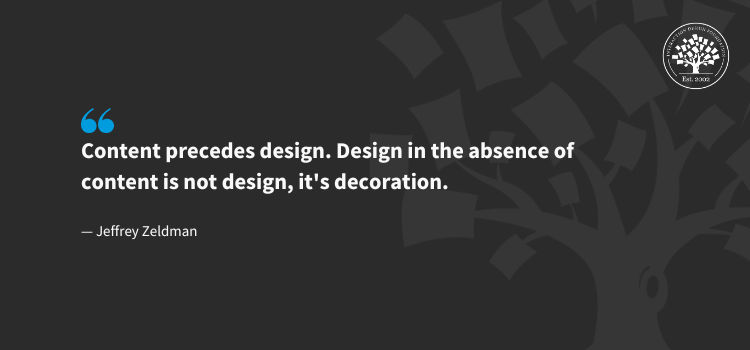
© Interaction Design Foundation, CC BY-SA 4.0
"Content precedes design. Design in the absence of content is not design, it's decoration."
— Jeffrey Zeldman
Web designer Jeffrey Zeldman’s quote might make you cast an eye back to the art-versus-design distinction earlier, and for good reason—not least as it emphasizes the importance of meaningful content in design—and the essence of his quote lies in the priority it assigns to content over design. The idea is that design shouldn’t exist for its own sake but to facilitate and highlight the content that delivers value to users, and so, dear designer of great things to come (or already great things if you’re already on your design journey), please remember that a design can look pretty, and it can be cool—and it can be pretty cool, too!
With that said, it might get pretty lost in the marketplace if it manages to escape, because if it’s got nothing in the form of meaningful content to reflect, it’ll be without purpose—and nobody will have a purpose to use it, either, let along pay for the privilege of doing so. So, do be sure to establish the content and design around it, so what comes out is a functional tool to enhance the content’s usability and accessibility for all to enjoy, and you can learn how to improve your content design strategy using UX ideas.
12. Theme: Storytelling in Design

© Interaction Design Foundation, CC BY-SA 4.0
"Design is storytelling."
— Ellen Lupton
Renowned designer Ellen Lupton sees design as a narrative medium—and, according to her, a well-orchestrated design does more than facilitate interaction; it tells a story. Every element chosen, every color used, and every line drawn contribute to this narrative, and so they’re powerful parts of something that people can relate to and so they can feel more "part" of what’s going on. What’s more, storytelling in design can serve practical purposes—such as guiding users intuitively toward desired actions or helping them understand complex processes.
Show
Hide
video transcript
- Transcript loading…
See why users love stories. Humans love a good tale—have done for millennia and always will do—so when you, dear designer, embrace storytelling in design, you can enhance aesthetics and boost functionality and user engagement—putting them in the picture.
13. Theme: Designing for Accessibility
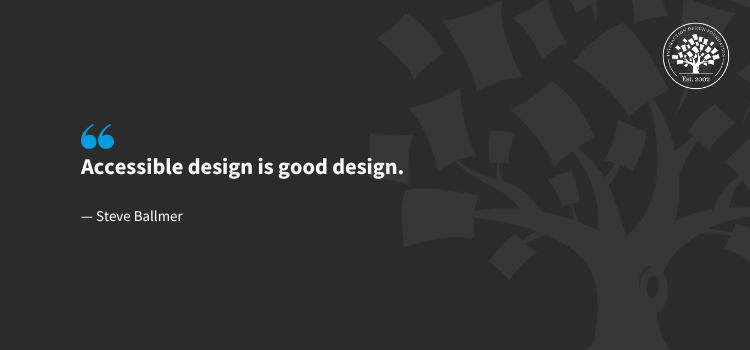
© Interaction Design Foundation, CC BY-SA 4.0
“Accessible design is good design.”
— Steve Ballmer
Steve Ballmer—a former CEO of Microsoft—has a quote here that asserts why accessibility in UX design is such a big deal, and it’s more than just a noble sentiment if you reflect on how it means that a design is only good if it is usable by all, regardless of their abilities. Accessible design isn’t just about catering to the needs and desires of individuals with disabilities—which is a vital thing to do in any case, not least because it’s the right thing to do but is the law in many jurisdictions as well.
There’s something else in this win-win equation of accessible design, and it’s that when you create that way, you’re also creating a universally friendly design that encompasses diverse user abilities and experiences. So, what that means at the end of the production line is a well-crafted design that isn’t just aesthetically pleasing but easy to access and intuitive to use for everyone as well—and it’s easy to recognize if you think of instances where accessible design has come to the rescue for whoever the user might be.
True design excellence does lie in its accessibility whenever you think of how it comes across in the form of such examples as subtitles in loud environments or well-designed color contrast for screens outdoors on a sunny day.
14. Theme: The Role of Research
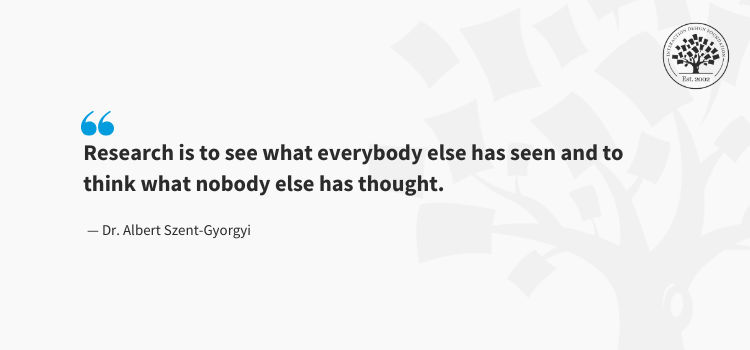
© Interaction Design Foundation, CC BY-SA 4.0
"Research is to see what everybody else has seen and to think what nobody else has thought."
— Dr. Albert Szent-Gyorgyi
The initial intent around Nobel-prize-winner Albert Szent-Gyorgyi’s quote may be geared around the world of biology, but it hits the nail on the head for other disciplines, too, and is—you guessed it—relevant to UX design in a deep way as well. It emphasizes why it’s so vital to try for—and succeed in—unique interpretations in research, not least because seeing the same data as everyone else isn’t enough; you’ve got to go deeper, or off to the sides, or above what they all make of it.
Sometimes the “data” can be staring someone the face but for some reason a key insight lies buried in the numbers and words—maybe the researcher has entered into the research with assumptions that dull their senses and prevent a keen eye from noticing that one vital thing that could unleash a revolutionary new insight. And, yes, thinking differently about that data and finding unique insights makes the difference in UX design—not least because what designers do is often at or near the frontiers of technological advancements that keep coming.
To “win” at the “game” of good research done well—and those precious innovative insights drawn up from the well-trodden reams of pages and screens—then it’s about looking beyond the obvious, uncovering hidden patterns, and translating them into innovative design solutions—and remembering that the power of research in UX design lies not just in observation but in the innovative thought process it triggers.
Watch this video to learn about UX research and why it is important in the UX design process.
Show
Hide
video transcript
- Transcript loading…
15. Theme: Designing for the Future
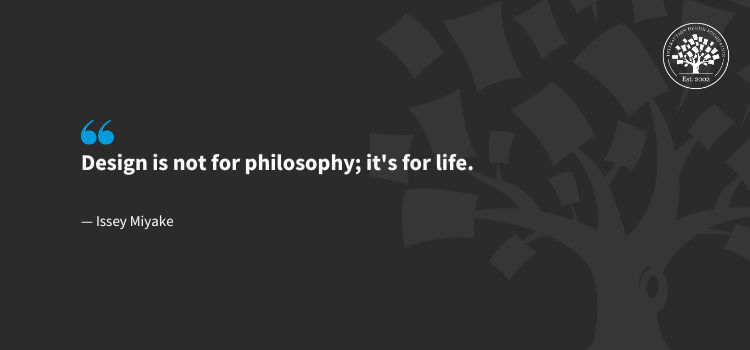
© Interaction Design Foundation, CC BY-SA 4.0
"Design is not for philosophy; it's for life."
— Issey Miyake
Issey Miyake—a notable fashion designer—has got a quote here that reminds us of a pretty important point, and it’s that design shouldn’t just ponder philosophical questions; no, it’s got to address real-life problems and needs, too, and, sure, the purpose of design extends far beyond intellectual exploration—something that can become mighty clear when a user has a real-world problem they need solved right away. They won’t have time—let alone patience—for high-brow principles that might be discussed at that very moment in a nearby university class, for example, even if the principles might have a bearing on what they’re going through. Instead, these users will have real needs as they try to solve tangible problems in the moment, and, to serve life (and real-life users), the design they want will need to have been driven by a deep understanding of users’ experience, pain points, and—of course—needs.
One more thing to ponder while in the vein of designing for life and real living needs is how this quote suggests a forward-thinking approach, a nifty one where design isn’t just reactive and addressing existing issues, but proactive—and anticipating future needs in the best way. Philosophical truths about living and the human condition are precious, to be sure, and so are the real-world in-the-moment needs of the users who experience that human condition. So, for meaningful design to carry anything of value, it’s got to lie at the intersection of philosophical thought and practical life application—so real users get the best of what the idea behind the solution offers them and your great design in this regard gets due recognition as such.
Watch as UX Pioneer and Author, Don Norman explains important points about why design is “hot.”
Show
Hide
video transcript
- Transcript loading…
How to Interpret and Apply UX Quotes
All right, those UX quotes are powerful ones and can provide us with insights and wisdom, but it’s often another story when it comes to extracting meaningful lessons from them and implementing them in our UX design projects. To “plug” these great nuggets into your work, there’s some great news on that—with a structured approach to interpretation and application, you can leverage these valuable words of wisdom and get them working for you as you make optimal designs for users.
How to Interpret UX Quotes
To start off with, think about the context of the quote.
Who said it?
In what situation?
What problem were they trying to address?
Do that and it can help you grasp the underlying message more effectively, and then, when you’ve got the “handle” on how to relate this message, you can get it across to your own design context. Think about, how does it fit into your design philosophy, your project goals, or the challenges you’re currently facing?
Take, for example, the nub of this quote, “More options, more problems.” It suggests that by reducing options, it can help avoid user decision paralysis—so, if you’re working on a project where users have to make choices, you might want to simplify these choices or guide users more effectively towards what they need or want to do.
Now you’ve got a UX design quote all interpreted the way you need to, it’s time to work these insights into your UX design project in a nice and practical way—and that implementation is going to vary depending on the quote’s theme. For instance, a quote that’s all about empathy can guide the user research phase, while quotes stressing the importance of simplicity can influence a project’s visual design and usability—and you lever things into place according to it.
How to Apply UX Quotes
Now you’ve got a UX design quote all interpreted the way you need to, it’s time to work these insights into your UX design project in a nice and practical way—and that implementation is going to vary depending on the quote’s theme. For instance, a quote that’s all about empathy can guide the user research phase, while quotes stressing the importance of simplicity can influence a project’s visual design and usability—and you lever things into place according to it.
For example, consider our very first quote here, the one by Antoine de Saint-Exupéry—“Perfection is achieved, not when there is nothing more to add, but when there is nothing left to take away.”—and you’ll find that to apply this insight, you might need to declutter an interface, remove unnecessary elements, and focus on core functionalities to enhance usability to the maximum for your product’s users. For that, you might think of how Google embody that quote with their beautiful and ultra-iconic search page, with its generous negative space and ultra-usable minimalism—and then think also how every quote carries a story of past experiences and lessons learned; so, use them as your stepping stones to create inspiring, impactful, and innovative designs.
What’s a Case Study of a Successful Implementation of a UX Quote Like?
Design with Usability in Mind: Amazon
Amazon has taken Steve Jobs’ quote, “Design is not just what it looks like and feels like. Design is how it works,” to heart in that—despite its vast range of products and complex underlying systems—Amazon’s website design is neat and straightforward and functional. It facilitates easy navigation, product search, and the purchase process in ways that users and customers the world over love—and have come to expect—and Amazon’s success underlines why it’s so important to prioritize usability in design.
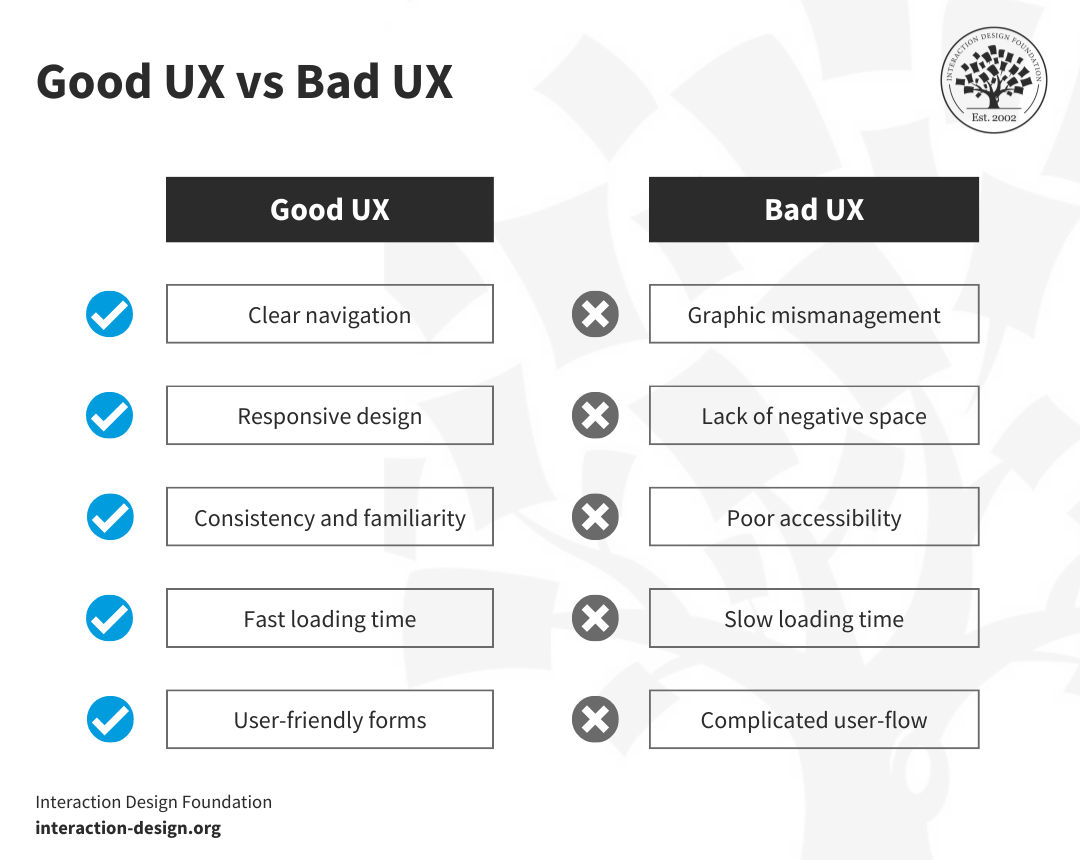
© Interaction Design Foundation, CC BY-SA 4.0
How to Build Your UX Quote Repository
A personal or team-based UX quote repository can be an invaluable asset to have at hand, and—far more than being just a “catchy” slice of philosophy—it serves as a reservoir of inspiration and wisdom, a place to turn to when you need a fresh perspective, or a reminder of fundamental design principles. And that’s more than just handy when you’re brainstorming for a new project, seeking guidance when design challenges come up, trying to instill a more user-centric culture in your team—or what have you.
How to Curate, Organize, and Utilize UX Quotes
The first step to take toward building a UX quote repository is to curate relevant—and inspiring—quotes, so do look out for insights and wisdom from UX design blogs, books, webinars, podcasts, and industry events—and don’t just limit yourself to UX experts; seek out wisdom from diverse fields, as long as it’s relevant to UX design principles and practices. Think about themes or topics—it’s essential to organize your quotes based on them for ease of reference (e.g., empathy, usability, simplicity, user research)—and then, often revisit and use good quotes in your design work, being sure to share relevant ones during team meetings, use them to kick-start brainstorming sessions, or include them in design presentations to emphasize a point.
You might just be amazed at how a few words or sentences can serve as a rallying call or “flag” to fire up your team’s energy and imagination in getting to grips with real-world problems on your UX design journey.
The Take Away
Actions may speak louder than words, and the power of words is something that many people often underestimate—or tend to overlook—but selected UX quotes prove to highlight the sheer wealth of wisdom they possess, and in just a mere handful of phrases, each encapsulates unique insights that can inspire, guide, and even revolutionize your approach to UX design, and so they’re tools as well as precious resources. For example, the next time you see a billboard out in public with a powerful quote on it or a poster in a room that bears a gem of a quote, think about how—rather than cute phrases to be left hanging on a wall, perhaps hidden in plain sight—the message is something profound that a designer might seize on.
The enduring relevance of the quotes in this piece—or their “timelessness”—lies in their ability to keep on resonating with evolving design practices, and they don’t just serve as decorative reminders but act as fuel for creativity, empathy, and user-centricity, essential elements in the ever-evolving world of UX design.
However, inspiration and wisdom from quotes are just the start of the journey. To turn these insights into practical skills, consider joining one of our comprehensive UX courses.
If you’re new to the field, join our beginner UX design courses today and build a solid foundation in UX principles and practices.
If you’re looking to take on more advanced roles, upskill with our intermediate courses today and drive your career growth.
No matter where you are in your UX journey, our courses can provide the knowledge, skills, and practical experience you need. Start your journey toward mastering UX design with us today!
